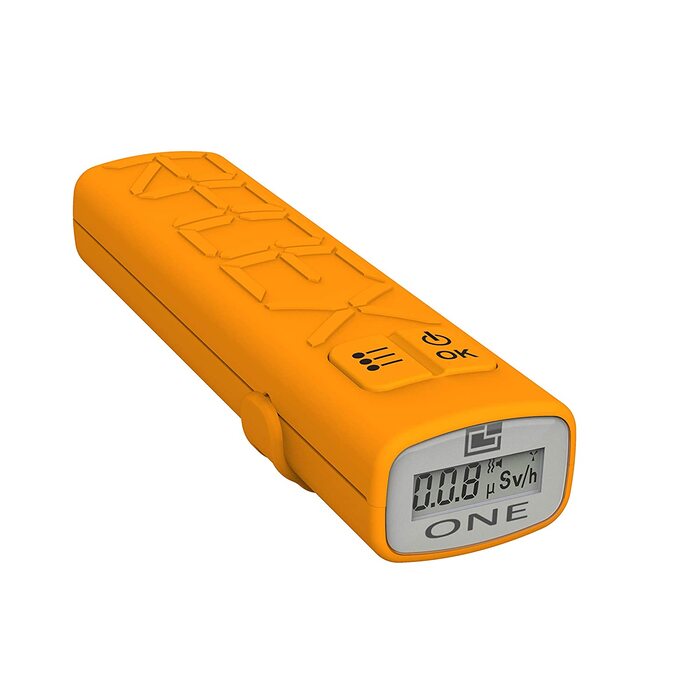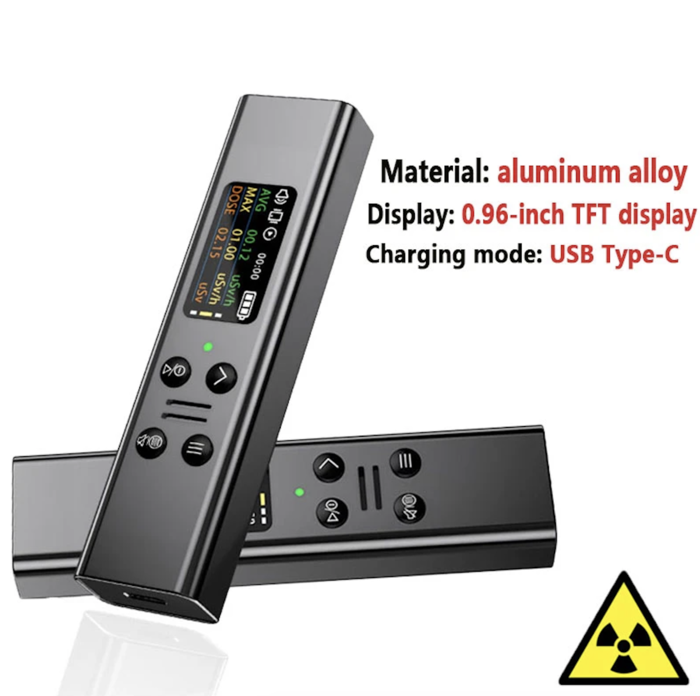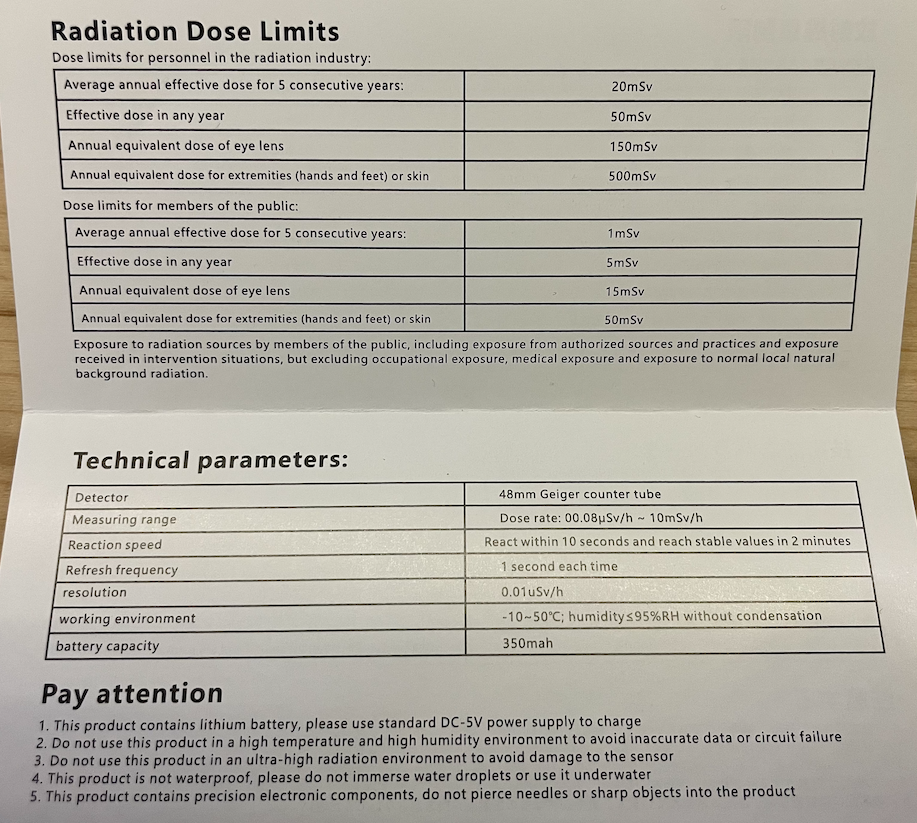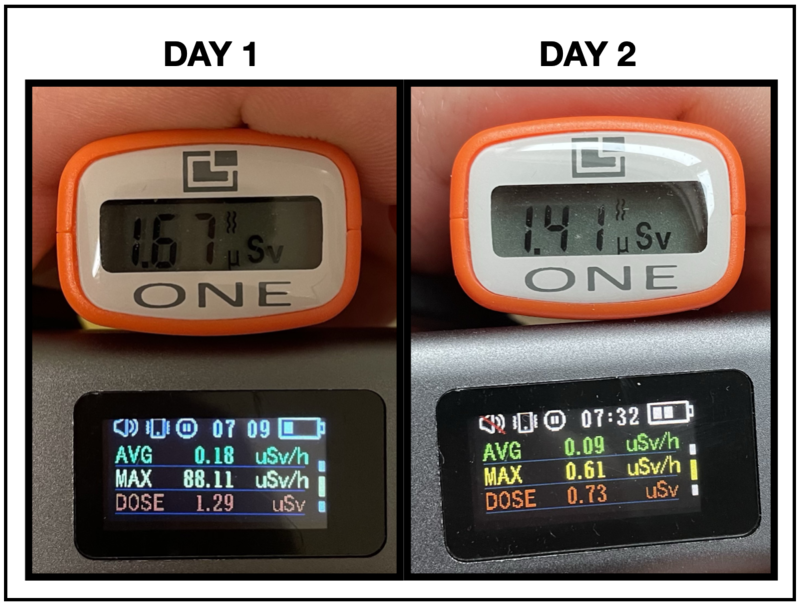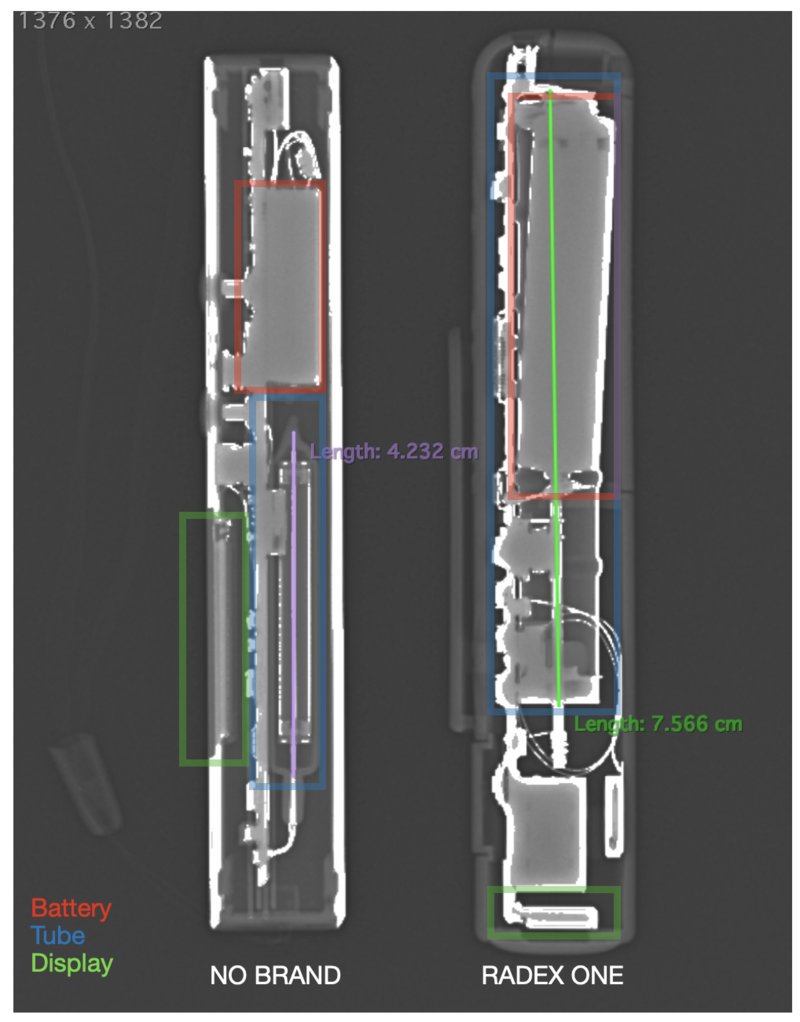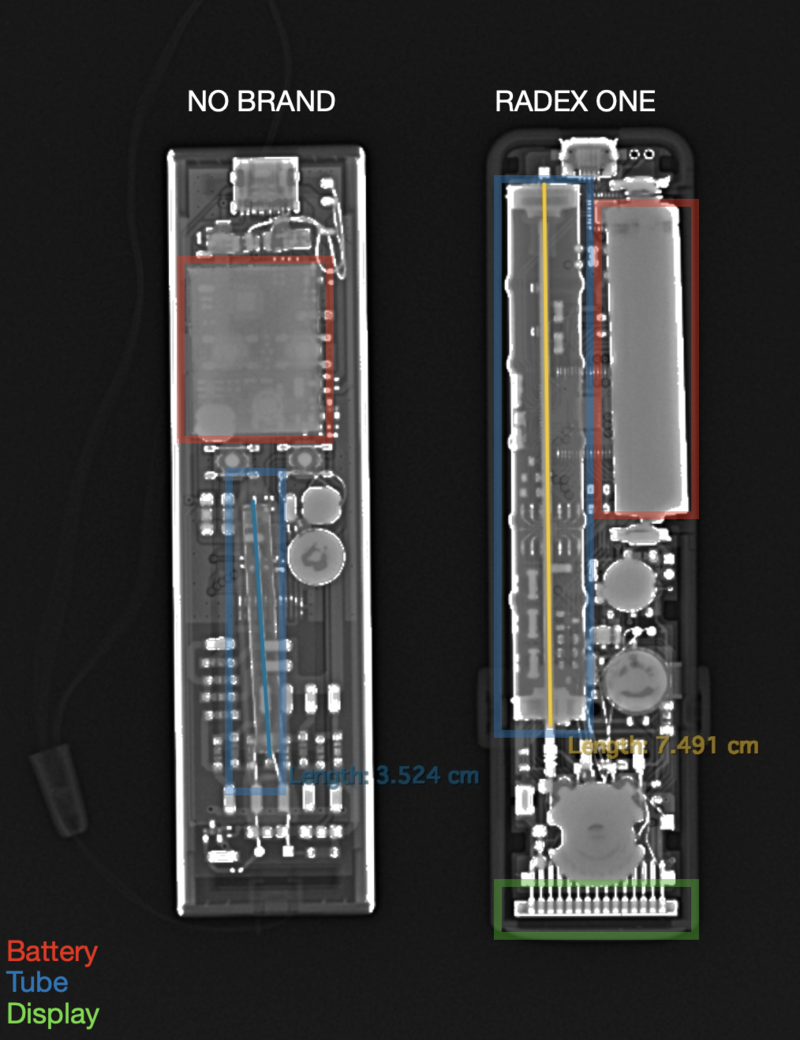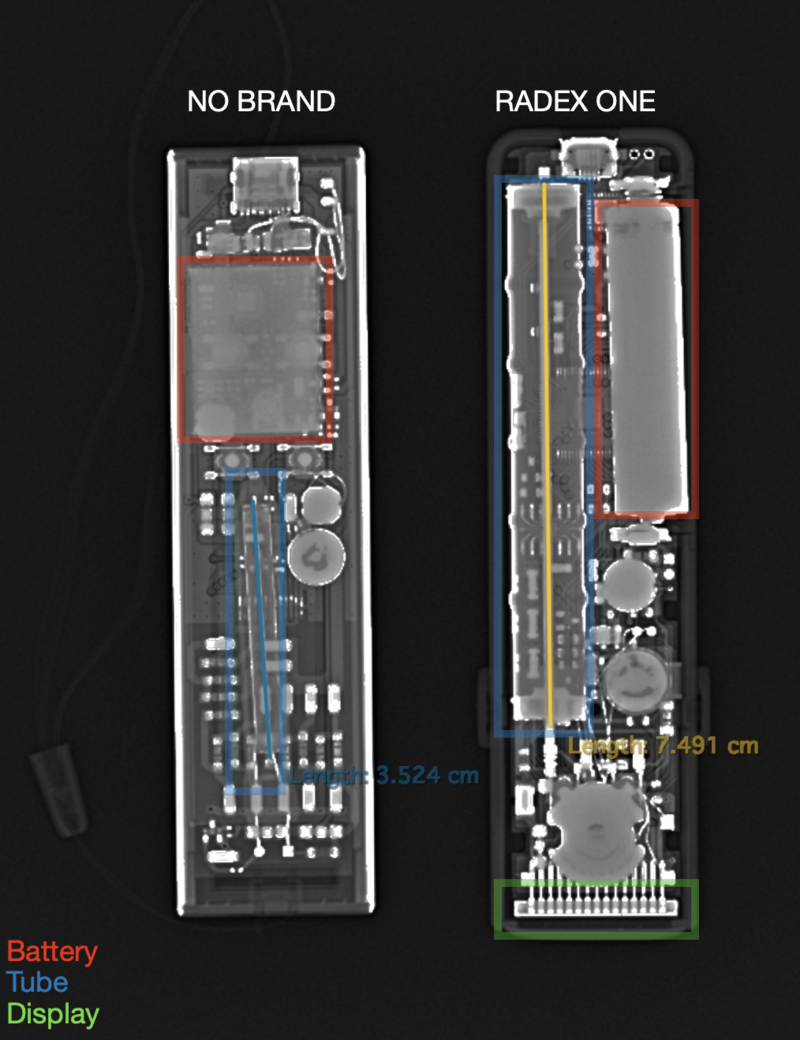- Forum
- Geiger counter discussions
- Commericial geiger counters
- Comparison between two poket geiger counters
Comparison between two poket geiger counters
- GuzzoTheLuke
-
 Topic Author
Topic Author
- Offline
- New Member
-

- Posts: 2
- Thank you received: 1
In this topic I want to analyze the two devices and compare each other in order to valuate the accuracy of the cheap one and give you my opinion about the products.
Radex ONE Outdoor edition
I bought this really nice geiger counter/dosimeter for around 150€ thanks to a big discount offered by a reseller (the actual cost of this product is about 300€, a madness for the product).It work out of a single AAA battery replaceable, but really durable (it is rated 3000 hours of operation time in silent mode). I've been using it for 4 month now and the battery is still the first installed using the geiger in vibration mode.
The device has a strong shell although is plastic made (with useless belt-clip) and the menu is quite friendly and easy to use with basic functions and cumulated dose stored in non volatile memory.
It use the SBM-20 GM tube, a well known and good quality tube with hight sensitivity to Beta, X and Gamma rays. The only downside is the lacking of a backlight for the display (visible only with an external light-source), I would have loved a BT or cable connection with my iPhone via a dedicated app and the possibility to have the complication on my Apple Watch showing the current dose-rate. I’m aware of the RD1212BT by Quarta Rad and the Radiacode 101 but I like the form factor and the cost of my Radex ONE.Finally I consider this a very good buy and I would buy another one, but only at the price of the first.The next image is the tech specs for the product.
No brand geiger
I've bought it on Aliexpress because I'm looking for a more cheap and every-day-carry dosimeter (also hoping in a sort of data logging function due to the usb c port available).Shipped fast and already charged the device offer great functions such as fantastic oled display, nice menu scrolling and useful data as average dose-rate, maximum dose-rate and cumulated dose.Silent and display off mode are available.The life of the integrated battery (on a single charge) is about 20 hours of continuous monitoring (approximately 2 shift and half) in silence mode and with displayed turned off.The cost was about 50€ and it seemed a good deal. I was wrong.
The next image is the technical specification only seeable in the user manual (not on the selling page):
The measuring range starts at 0.08 uSv/h and the geiger at the startup display immediately this value without taking his time to receive impulses from the tube. The result is a totally unreliable data that didn't change a lot during the background monitoring. (My house background is in the range 0.10uSv/h - 0.25uSv/h, value never reached)
On the manual there isn't any indication of the tipe of the GM tube on witch is the geiger based on.
During the various shift-long test the device appeared to be not accurate compared to the QR's Radex One. More in the Comparison section.
Comparison
Once fired up the new brand free geiger I start suspecting that it was laking of accuracy so I decided to test it in the field and compare it with che other geiger of the same category. I brought either the Radex ONE and the Aliepress’ one in my pocket during the shift 7/7:30 hours long.
The results was the following.
Day 1
Radex ONE : 1.67 uSv
No brand: 1.29 uSv
Shift duration: 7h
The difference is (1.67-1.29) 0.38 uSv
1.67:100=0.38:x
x=22,76
The no brand one was off by almost 23%
Day 2
Radex ONE : 1.41 uSv
No brand: 0.73 uSv
Shift duration: 7:30h
The difference is (1.41-0.73) 0.68 uSv
1.41:100=0.68:x
x=48,2
The no brand one was off by 48%
Notice the max dose-rate reported by the no brand geiger (88.11 uSv/h): it is unrealistic considered that it was a CT scan shift and I’m always behind a lead shielded wall.
I wanted to investigate deeply to find out why the Aliexpress’ model is so much inaccurate. I focalized my attention to the tube; I tried to tear apart the cheap model without destroying it to inspect what kind of GM tube was installed, but the end caps were well sealed, so I decide to X ray it and I also X Rayed the Radex for comparison.
Lateral View
Frontal View (postero anterior, the image is mirrored)
The Radex one open (web image)
Radex One
You can immediately notice the SBM-20 tube long 7.5cm (diameter: 0.9cm) marked in blue, the LCD with no backlight (green) and the AAA battery marked in red.
Notice the plastic case with good radio-transparency.
No brand
The color code is the same: Red for the integrated lithium battery, green for the display visible only in lateral view due to the overlap with the board and the tube (blue).
The tube is an unknown glass-type model long 3.5cm with an overall diameter of 0.6cm. I wasn’t be able to find any similar tube online for knowing the technical specs. I even asked to the seller but I never heard he back.Notable is the aluminum shell that is hardly radio-opaque on the side due to the overall thickness of the walls, almost irrelevant on the trajectory of ionizing rays on their travel to the tube.
Conclusions
I do not recommend the Aliexpress model but I really appreciate the work of Quarta rad with the Radex one, I hope the company will produce a iOT/smart geiger, economic and connectable to our modern world.
This topic is only the reflection of my opinion with the limitation of my not complete knowledge in this enviroment.
Thanks
Luca from Italy
Please Log in or Create an account to join the conversation.
I won't say much about the Radex One because it appears to be a fairly decent, solid, reliable, usefully accurate counter/dosimeter, and there is little to criticize. It uses a time-served old faithful SBM-20-1 tube (the SBM-20-1 is the same as an SBM-20 with different connecting pins), and on the face of it, it looks to have a decent HV PSU. At least going by the expense of the components used as the transformer would probably be one of the most expensive components in the counter, less the GM tube and microcontroller. I would grab one, but only for super cheap as I have too many counters already. Nice for my collection, but I probably wouldn't use it, hence super cheap.
The no brand counter interests me a lot more though. It's crapy but I find it interesting nonetheless, and not necessarily useless, just very basic. It seems very similar to my Chinese pen type dosimeter/counter, which too is a no brand, but with a model number . My pen counter can be seen here: https://radmon.org/index.php/forum/commericial-geiger-counters/1287-hps-p3-pen-geiger-counter-dosimeter
I think the tube in your no brand is the same tube as in my pen counter going from the dimensions and x-ray photo. I contacted one supplier of my pen counter and they were no help so I scoured the internet and I could only find a couple of tubes that seemed the same, going from looks and sizes. Mine is labelled HH614, but I couldn't find that at all on the net. The closest match was a J614y. It is possible the manufacturer of the counter ordered a load of GM tubes with custom markings, or there simply isn't any info in English on the tube. There may be in China/China's internet (search: great firewall of China.)
I think the tube is not very sensitive at all. Maybe 1/4 - 1/5 that of an SBM-20 and I don't have the details on it's dead time. It may have a higher dead time than the SBM-20, and please correct me if I am wrong, but for x-ray dosimetry it requires a fast counter/dosimeter as all of the rays are emitted in a very very short time, so it has to be able to count all (or as many as it can) the rays with as little dead time as possible between each detection. The SBM-20 has a dead time of 190uS meaning it could potentially have a maximum count of 5263 counts per second. Say the no name tube has a dead time of 300uS, that would make a maximum theoretical count of 3333 counts per second. Then there is how sensitive the actual tube is. The SBM-20 has a much much larger surface area than the no brand and as such will be capable of detecting more rays because there is more tube in the path of the rays. Smaller tube means less in the path of the rays. So in conclusion, the no brand would simply be a less sensitive tube. It won't detect as much as the SBM-20 and may not count as fast if it has a longer dead time.
If your no brand is similar to my pen counter, the USB has no form of communications and is just used for charging. I get about 50 hours life out of my pen counter, provided I never let the screen light up. I get a lot less if I keep activating the screen. I also don't understand why they cased it in aluminium! Geiger counters 101 dictates that any metal shielding will reduce it's sensitivity. I would reckon the case is maybe 0.3 - 0.5 mm thick so that is any soft beta stopped right away. In fact any low energy rays/particles will be stopped. Take a not so sensitive GM tube and then make it less sensitive by shielding it! Stupid idea in my opinion! I guess the makers are either idiots or only interested in sales and don't really care about their products.
So I think it may be those reasons why you are getting a large discrepancy in the readings of the two counters. Generally, the no brand is less sensitive than the Radex One. I do think the no brand isn't entirely useless though and would have a purpose for ionizing radiation, but not x-rays. I'm pretty sure it would alert you to higher levels of radiation, but may not be so accurate with the actual reading.
You also pricked my interest mentioning film dosimetry. That is something I heard of some time ago, but I had assumed (foolishly) thjat with it being 'film' it was an old and buried technology. Seems it is quite old (developed 1930's) but I was surprised when you said that you use that today. I can imagine the film would have no dead time whatsoever and if every ray hit an area of the film that has not been hit then it would equate to a pretty decent dose reading, providing it was developed properly. A downside to this is you don't get the results instantly and have to wait for developing. I was curious so I asked chatGPT what it thought to the difference between film and GM tube dosimetry and also asked about when it was developed (created). ChatGPT said this:
Question: Is a film dosimeter better than a geiger muller dosimeter for x-ray dose?
Question: When was film dosimetry developed?A film dosimeter and a Geiger-Muller (GM) dosimeter are two different types of radiation detectors that are used for measuring ionizing radiation, including X-rays. Both types of dosimeters have their own advantages and disadvantages.A film dosimeter, also known as a film badge, uses photographic film to record the exposure to ionizing radiation. It is typically worn by personnel working in radiation areas, and the film is analyzed after use to determine the dose received. One advantage of film dosimeters is that they provide a permanent record that can be stored and reviewed later. However, film dosimeters require a processing laboratory to analyze the film, which can be time-consuming and expensive.A Geiger-Muller dosimeter, on the other hand, uses a gas-filled detector to measure ionizing radiation. It is typically used for more immediate measurements of radiation levels and is often handheld. One advantage of a GM dosimeter is that it provides a real-time reading of radiation levels, allowing workers to take immediate action if necessary. However, GM dosimeters have a limited range and can be affected by electromagnetic interference, which can affect their accuracy.In terms of measuring X-ray dose, both film dosimeters and GM dosimeters can be used, and each has its own advantages and disadvantages. For most applications, a film dosimeter is typically more accurate than a GM dosimeter, particularly for low levels of radiation exposure. However, if real-time measurements are needed or if the radiation levels are expected to be high, a GM dosimeter may be more appropriate.Ultimately, the choice between a film dosimeter and a GM dosimeter for measuring X-ray dose will depend on the specific application and the requirements of the user.
Film dosimetry was first developed in the 1930s by scientists at the Eastman Kodak Company in Rochester, New York. The technique involved the use of photographic film, which was sensitive to ionizing radiation, to measure and record radiation exposure. At that time, film dosimeters were mainly used for medical applications, such as measuring the radiation dose received by patients during X-ray procedures. Over time, film dosimetry has become an important tool for monitoring radiation exposure in a variety of settings, including nuclear power plants, research facilities, and industrial environments.
All very interesting stuff!
Please Log in or Create an account to join the conversation.
- Forum
- Geiger counter discussions
- Commericial geiger counters
- Comparison between two poket geiger counters

